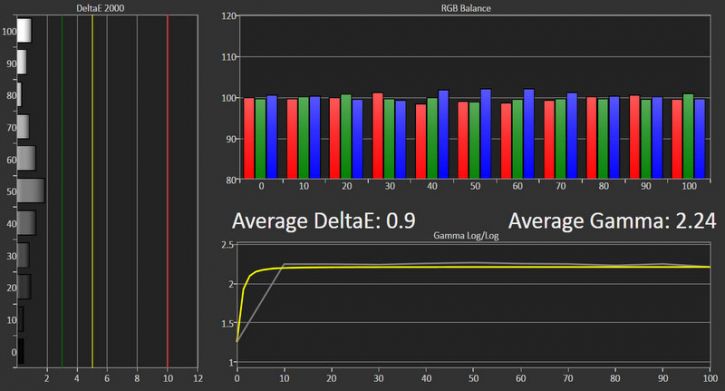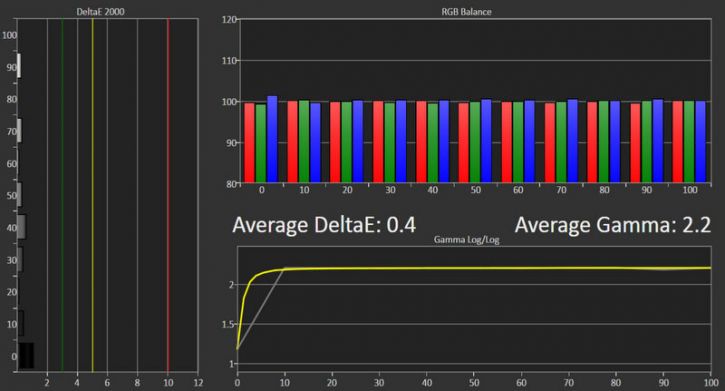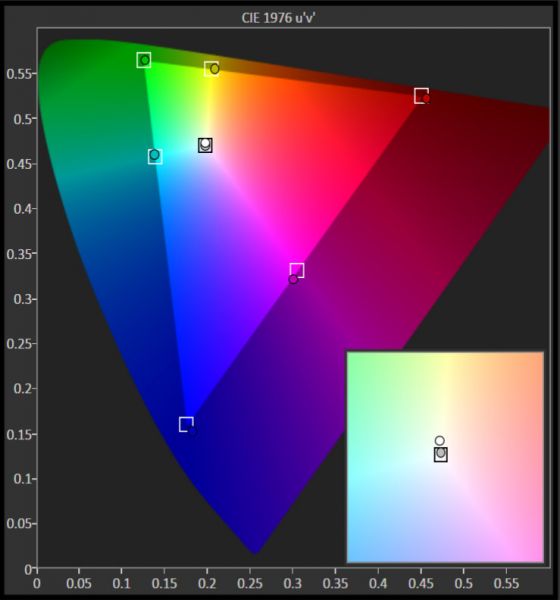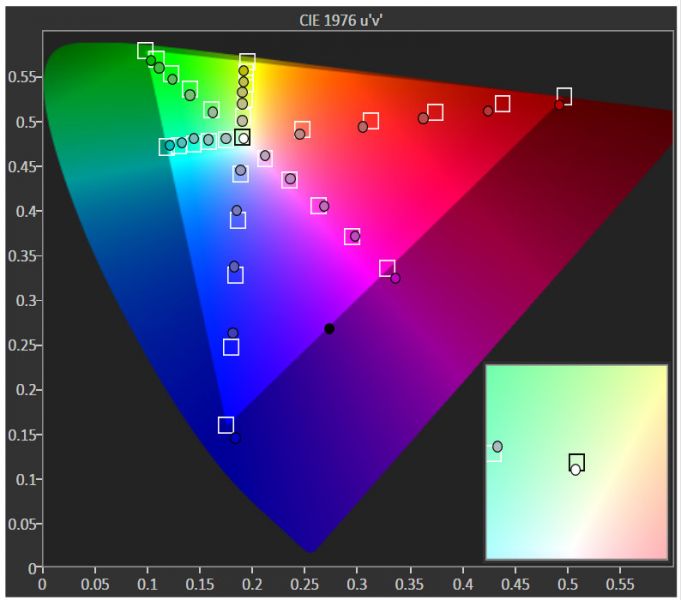Most television manufacturers are transitioning all mid-to-large sized 1080p offerings to 4K Ultra High-Definition (UHD) resolution within the next couple of years. However, quadrupling the pixel count has proven to be a relatively easy evolutionary step compared to the accurate expression of the UHD format's expanded color palette and luminance range. For videophiles looking to future-proof a display investment, the 2015 flagship models appear ready to fully support UHD video presentation even if some features will arrive later in the form of software updates.
Samsung's best 2015 TVs are branded under its new "SUHD" series of televisions - the "S" not really standing for anything specific other than the company's way of identifying a flagship product like its popular Galaxy S smartphones and tablets. The SUHD family of TVs incorporates Samsung's latest display technologies which aim to deliver deeper, richer colors and improved contrast compared to anything the company has offered before. SUHD-specific features and technical highlights include:
There are three main series of SUHD TVs: JS8500, JS9000, and JS9500. The 8500 and 9000 feature edge-lit backlighting with flat and curved screens respectively, and the largest screen size within the 9000 series is now the sole occupant of a recently added JS9100 series. The curved screen 65-inch Samsung JS9500 (UN65JS9500FXZA) that I am reviewing here earns its flagship status with a full-array local dimming (FALD) LED backlight system and retractable 1080p camera centered on the top edge of the screen. The JS9500 is available in screen sizes of 65-inches, 78-inches, and 88-inches.
The Setup
Unboxing the JS9500 for setup is best accomplished with an extra set of hands as the 65-inch version that I tested weighs in at just over 72 pounds and is a bit too large to manage on one's own. A good Phillips-head screwdriver and eight fasteners later had the TV perched upon its elegant brushed metal Y-shaped base which complements the screen's slim chamfered bezel design. The interface between the stand and TV wasn't as rigid as I would have liked, but it didn't feel like it would easily topple. Included spacers enable standard wall mount hardware to be attached to the set's curving brushed-finished backside.
Powering the TV on for the first time greets the owner with an initial guided setup that is clear, concise, and simple enough: agree to the lengthy terms and conditions (or sacrifice Smart TV features) and, in my case, run an impressively fast channel scan for local stations. The introduction concludes with a brief tutorial on use of the RF remote control.
Remote Possibilities
The new Samsung Smart Control remote's slim curved baton-style design feels great in the hand, and its brushed finished face and textured back effectively minimize fingerprints. The relatively compact remote has just enough heft to give it a substantial feel, and sculpted finger grooves assisted with proper orientation and grip. Although the new remote has a partially backlit keypad for use in dimly lit environments, its separate directional pad and pointer activation button lacked the tactile feedback and ease of blind location of its predecessor's larger combined control configuration. The new remote's Nintendo Wiimote-like cursor control proved accurate and jitter-free making the lack of a traditional remote a non-issue for me.
We're All Connected
The JS9500 locates all A/V ports in an external box dubbed the One Connect. This box links to the back of the TV via a custom 2-meter data cable; the 78-inch and 88-inch JS9500s include a 3-meter cable. Samsung indicated that One Connect cable lengths beyond 3-meters were unlikely due to the system's extremely high data rates so wall mounting configurations may be limited if an in-wall wire run is desired. The purpose of this external box? Upgradability. If some new connector gains traction in the future (HDMI 3?), owners of the JS9500 will need only to replace a small affordable input/output box, instead of a large expensive display panel.
The One Connect box incorporates four HDMI ports, three USB ports (one USB 3.0 at 5V/1A), and a dongle that provides legacy analog connections. All HDMI ports accept 2160p video input at 60Hz with 4:2:0 color sub-sampling, 2160p at 30Hz (4:4:4), and 4096x2160 at 24Hz (4:4:4). A menu option enables 8-bit 4:4:4 input at 60Hz; 10-bit and 12-bit input at 60Hz require 4:2:2 or 4:2:0 component video signaling. All HDMI ports are HDCP 2.2 enabled for use with protected UHD video source devices and content. Samsung informed me they will eventually offer an update to enable HDMI 2.0a for compatibility with upcoming devices such as Ultra HD Blu-ray players but further details were not provided.
The SUHD TV's wireless networking options include Wi-Fi (802.11 a/b/g/n/ac), Wi-Fi Direct, and Bluetooth. Samsung's Bluetooth implementation in its televisions has long provided mouse and keyboard support (convenient for use with the built-in web browser), and the JS9500 adds Bluetooth headphone compatibility for wireless private listening options.
OTA, Is That Still a Thing?
Cord-cutters will find the JS9500's Over the Air (OTA) digital tuner delivers fast channel scanning and superb sensitivity for pulling in local stations. Program information at the top of the screen includes audio and video format details, date and time, and station identification. Channel surfing using a scrolling pop up menu on the right side of the screen is simple and speedy, however, paging through the attractive full screen channel guide can be a bit sluggish leaving you waiting for information to populate the grid-style presentation.
Don't get too excited by the on-screen remote's record button as this DVR-style feature is disabled for North American markets.
Apps Aplenty
Samsung's switch to its Linux-based Tizen operating system for its 2015 smart TVs is a mixed bag. The updated interface, with its larger app tiles, appears crisp and appropriately detailed for a 4K UHD screen. I also like being able to finally use the on-screen cursor with Netflix, but many other apps including Pandora, Vevo, M-Go and others have not received a cursor control update. As a baseball fan, the lack of the MLB.TV app is disappointing. I believe more will be upset with the absence of HBO Go. Also, Samsung's own Milk music platform failed to make the transition - perhaps unsurprising given recent layoffs in that area.
UHD streaming via Amazon Instant Video and Netflix remains appreciably more detailed compared to the 1080p equivalents. M-Go, UltraFlix, and YouTube further expand the JS9500's selection of 4K viewing options, but the Xfinity UHD streaming app has yet to appear in SUHD-ville. While we were finalizing this review, Amazon announced HDR (High Dynamic Range) would be available, starting with season 1 of the Amazon original series, "Mozart in the Jungle." You'll find more about that below in our "UHD Viewing" sectrion.
Given the crappy selection of games on most smart TVs and the often worse ability to adequately control the action, I was especially pleased to see that Sony's PlayStation Now game streaming service would be a standard SUHD feature. However, a message on the app's placeholder indicates that it won't arrive until later this Summer.
Update (7/19): The JS9500 (and many other 4K UHD Samsung TVs) have received the app update for the PlayStation Now game streaming service. The use of a DualShock 4 controller appears to be mandatory as we were unsuccessful at getting an older DualShock 3 controller to pair with the JS9500 as we were able to do so with some premium 2014 Sony UHD TVs. The selection of games available on PlayStation Now was impressive enough for us to forgive Samsung for making us agree to a laughably long (300 page!) TOS agreement for the required Samsung online account.
The JS9500's Multi-Link Screen feature enables a split-screen view where half of the screen can display video from a connected source device while the other half displays an app or web page. It is easy to switch audio sources or control either half without any signs of slowdown.
Super Calibration-istic
Samsung's best TVs receive a factory white balance calibration before going into the box, and the JS9500's Movie picture preset proved well-tuned to deliver an accurate and faithful representation of HD video sources as noted in the default grayscale measurements below.

DeltaE 2000 grayscale errors below 3.0 (green line) in motion video are considered unnoticeable to people with normal vision. The JS9500's 2- and 10-point white balance controls proved effective at further improving grayscale accuracy as seen in the post-calibration results below.

Likewise, the TV's HD color space coverage exhibited excellent accuracy with primary and secondary hues. The JS9500's color management system (CMS) was more rudimentary than I've seen in competitors' products, but the end results were satisfactory.

Beyond High Definition Color
The JS9500's quantum dot-enhanced backlight system enables increased color saturation as well as an extended color gamut compared to regular LED backlighting. With HDR sources that feature expanded color palettes, Samsung recommends using the TV's automatic color space setting, which negates the use of the CMS controls. After performing a basic white balance calibration with this configuration, DCI (P3) color space coverage and accuracy were quite good as indicated in the chart below.

Let There Be Light (And Lots of It)!
The primary advantage that the JS9500 has over its SUHD siblings is its full array local dimming backlight system. Local Dimming enables enhanced contrast through increased light output and the ability to dynamically reduce brightness in darker portions of the video picture when content requires it. Displaying a 2% white window, the TV produced about 790 nits in its brightest picture configuration. Increasing the window size to 18% reduced the output slightly to 697 nits. For comparison, a 2% window test with the 2014 Sony X950B produced a measurement that exceeded 910 nits, however, Sony's 2014 model year set won't receive an update to support HDR metadata and instead will produce an "HDR-like" viewing experience (unlike the JS9500's native HDR support).
Update (7/19): Samsung requested that we retest the peak light output of the JS9500 as they believed our results were lower than expected. After resetting the TV and configuring it for HDR viewing at maximum brightness, we did in fact record an increased peak output of about 930 nits when measuring a 2% window at 100% white. However, subsequent measurements after the TV had been operating for 10-15 minutes measured about 5% less and continued to slowly decrease over time. Larger window sizes like 18% remained at a consistent brightness over time. We've reported our findings to Samsung and await a response.
Video Processing
Samsung TVs are the gold standard for consistent and effective video processing. Picture detail is enhanced while potentially distracting image artifacts are minimized. The JS9500 aced the classic 1080i HQV benchmark disc compared to the Sony X900B and X950B TVs which left jagged edge artifacts in the diagonal filter tests.
Samsung's better TVs, including the SUHD models, feature independent controls for enhancing the motion resolution of content captured at 24 and 30/60 frames per second. These independent controls make it easy to avoid the unnatural smoothing of video motion with movies and prime time TV shows (24 fps), a.k.a. "soap opera effect," while enhancing the clarity of higher frame rate content like sports programming.
The classic FPD Blu-ray benchmark disc proved the JS9500 was able to resolve all 1080 lines of detail compared to the 300-350 lines for all other LCDs that lack motion resolution enhancement or have the feature disabled. I noted a slight hiccup at the 900-line mark in this test that vanished completely when LED Clear Motion (backlight blinking) was enabled. LED Clear Motion's primary benefit is improved motion resolution with all video content without altering the look of the presentation, but the downside is a reduction in overall brightness and an increase in flicker that some (including myself) may find visually unacceptable.
Gamers will appreciate the JS9500's appropriately named Game Mode setting that reduced video lag from 137ms with the calibrated Movie picture mode preset enabled to an impressively brief 24.7ms - less than two video frames of delay with 60Hz input.
Uniformity
Disabling the JS9500's local dimming feature (Smart LED) revealed significant uniformity anomalies when displaying full frame gray test patterns. Dark gray frames were especially heinous with glowing multi-hued cloudy spots throughout the picture. Bright white patterns exhibited similar uniformity issues although less drastic in appearance. That said, it's unlikely that JS9500 owners will disable this key feature since it's responsible for much of the TV's picture performance. And, it was impressive to see how the TV's active local dimming system and per-pixel video optimizations improved overall uniformity while local dimming was engaged.
Viewing exams
The Samsung JS9500's local dimming system produces twice as much light as a regular LCD television, and more peak luminance detail than the other SUHD TVs. Add to this an effective anti-reflective screen surface that further enhances contrast, and the JS9500 produces one of the most eye-pleasing visual experiences I've had to date. The viewing of quality Blu-ray and UHD video sources exhibited depth and detail that rival any display system I've seen. However, the JS9500 is an LCD at heart and off-axis viewing was its weakness. Seated front and center, the JS9500 is an unrivaled display system, but shifting one seat left or right sacrificed contrast and color saturation that was especially noticeable in a dark room viewing environment. Although less noticeable in normal-to-bright room viewing scenarios, off-axis dark room viewing was tainted by halos around bright objects on dark backgrounds and slightly desaturated skin tones.
The Blu-ray presentation of "Samsara" is a visual feast of a world tour that was exquisitely produced from 8K scans of 70mm film stock. Side-by-side comparisons with a calibrated Sony X950B showed the JS9500 maintained better black levels in letterboxed bars but the Sony did a slightly better job of revealing the darkest details. The presentation's many sky and desert panning shots revealed no signs of dirty screen effect (DSE), and the 9500's terrific grayscale performance resulted in fantastic natural detail - detailed skin tones in the prison exercise yard scene were a highlight.
3D is supported by the JS9500 and the set comes with one pair of SSG-5150GB active RF 3D glasses. Additional sets of glasses are available on Amazon for under $20/pair, if you're into that sort of thing.
UPDATE (7/19): We dug into the 3D a bit, and classics like "Hugo" and the PlayStation game "Super Stardust HD" exhibited convincing 3D effects. The frequent closeups of "Hugo" revealed some crosstalk with bright or dark outlines around his face, but scenes with natural colored objects like wood grain, flowers, and baked goods appeared detailed and artifact free. Gaming with "Stardust" in its 3D mode was enjoyable as explosions leapt from the screen and the fine-lined grid surrounding the planetary playfield was crosstalk-free. I prefer the additional brightness of passive 3D technology as well as the awesome clip-on glasses that are available, but the JS9500's lightweight glasses fit well over my prescription specs and the TV has plenty of light output for a convincing 3D presentation.
While purists will likely disable the TV's de-judder enhancement altogether, I found that increasing it to 1 or 2 (out of 10) slightly tamed the related artifacts without rendering the video unnaturally smooth. Turning the setting up to 6 or 7 drastically improved motion resolution of 24p content but at the expense of faithful reproduction.
Viewing "The Dark Knight" in a dimly lit setting allowed the JS9500's precise white balance calibration to shine compared to the more limiting 2-point setup provided by the Sony X950B. Front and center, the movie's many dark details were inky and the wide variety of skin tones were pleasingly natural. However, Bruce Wayne's fair skin highlighted the SUHD's viewing angle limitations especially compared to OLED televisions like the LG EC9300. The Sony X950B also exhibited off-axis desaturation but at wider viewing angles compared to the SUHD
UHD viewing
4K UHD content is still fairly hard to come by, HDR-encoded and wide color gamut-enabled content even more so. Samsung provided a couple of UHD trailers with HDR encoding with an expanded color palette and this content highlighted how much better home video can look compared to the current HD standard. Richer, deeper reds and greens combined with impactful peak bright details add much more to the viewing experience than increased resolution alone. Even when streaming today's non-HDR/non-expanded color UHD video from the likes of Amazon, Netflix, Ultraflix, and others, the JS9500's ability to deliver epic contrast in bright and dark room conditions hints at what is to come later this year as streaming services incorporate HDR-authored and encoded offerings.
While we were completing this review, Amazon updated its video streaming app on Samsung SUHD TVs to support the delivery of HDR-enhanced content, and the initial selection includes the first season of "Mozart in the Jungle" and the pilot episode of "Red Oaks." Examining episodes before and after the HDR update, the JS9500's astounding peak brightness while preserving dark details made for an impressive presentation. Sunlight scenes appeared more realistic with intense highlights. A single lamp illuminating a windowless room was almost too bright to gaze at directly. Glinting highlights on polished instruments made for a pleasing and subtle improvement. Amazon's currently limited HDR offerings on the JS9500 rank among the most visually impressive experiences I've had with LCD technology and I look forward to seeing the selection grow.
Turn-Ons:
Turn-Offs:
Final Thoughts
The Samsung JS9500 delivered an impressively dynamic viewing experience under a wide range of viewing conditions - viewing angles notwithstanding. Its performance with today's HD content is as good as I've seen from any manufacturer's LCD television, and its reproduction of HDR-enabled 4K Ultra HD content was truly stunning. I expect the SUHD series to improve even further as new software updates are released, minor bugs squashed, and promised features added. The JS9500's forward-looking display technology doesn't come cheap as my 65-inch tester is about $5,000 online and jumps to $20,000 for the drool-worthy 88-inch version. However, this investment gives the distinct impression that it's in a rare class of 2015 TVs that stand ready to fully support all aspects of the UHD format.
Model Details:
Where to Buy:
| Overall | |
|---|---|
| Value | |
| Performance | |
| Features/Ergonomics |